Studies showing cancer reversal / shrinking
-
Tissues are permeable to CO2, but unlike internal tissues, it seems that the packed organization of the skin inhibits the diffusion of CO2.
I had in mind that a CO2-saturated gel would be superior to CO2 in air, but inferior to direct contact with 100% CO2 gas, making the gel work more as a barrier. However, it can be pressed against the skin to move other components out and maximize absorption.
The pH of the solution decreasing shows that CO2 was yielding some carbonic acid, which further complicates absorption when it ionizes (CO2 + H2O → H2CO3 → H+ + HCO3–), although the skin pH is about 5.
Another advantage of direct gas exposure would be quick renewal. With the gel, the redistribution of CO2 towards the contact sites can be slower.
What am I missing?
-
Methionine restriction to enhance Rapamycin (& high dose thiamine possibly as a CA inhibitor but less so)
https://bioenergetic.forum/post/26937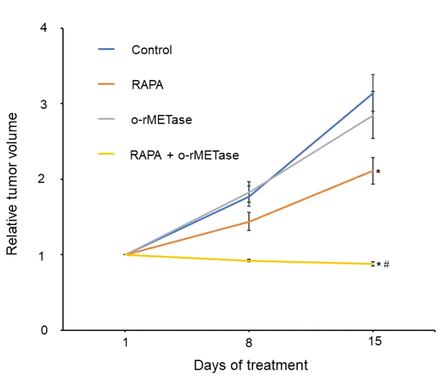
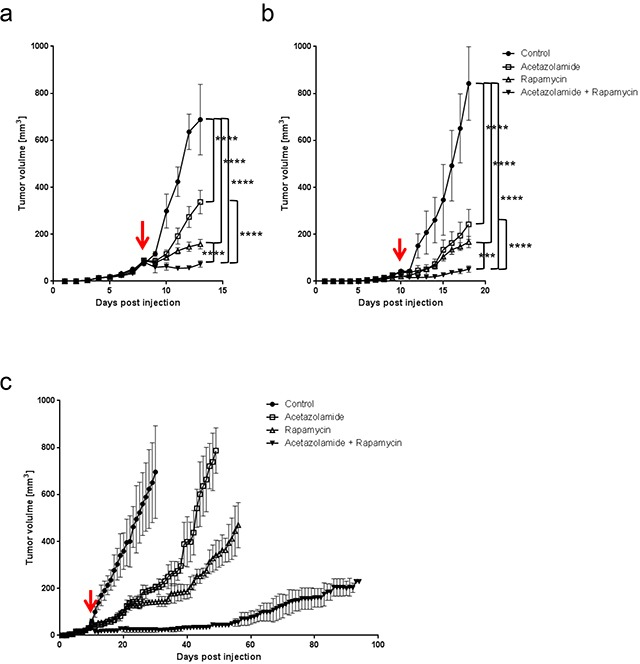
-
@cs3000 said in 2 studies showing cancer reversal / shrinking:
@cs3000 said in 2 studies showing cancer reversal / shrinking:
@Mauritio yep and i imagine daily would be even better, interesting that short duration was effective it does work broadly yeah
here it had less profound effect in a connective tissue cancer but still good
https://www.ncbi.nlm.nih.gov/pmc/articles/PMC3499556/#s2title they did 10 minutes instead of 20 minutes .
I just saw something amazing actually when they tested it on breast cancer in vivo it almost didnt grow at all :Here we go, big one
https://www.spandidos-publications.com/10.3892/or.2017.5591
great studies by these people exploring all the anglesSurprisingly going for more days of co2 weekly didnt give better effect, 2 days is enough,
but going for longer than 10 minutes does give more improvement (20 minutes worked better) in breast & bone cancer, effect peaks around there as 1 hr did not give better effect- Additionally, in a preliminary study, no further decrease in tumor volume was observed with the 1-h treatment compared to the 20-min treatment
- For the CO2 therapy, there was no difference in effectiveness of frequencies of twice and five times per week; in addition, a twice-weekly treatment regimen was sufficient to inhibit in vivo tumor growth, even in MFH/UPS, which is a high-grade sarcoma cell line.
And they found the cancer regressed below baseline with 20 minutes applications, in all of the mice
And they even said two of the breast cancer tumors disappeared @haidut
Bone tumors also got smaller below baseline
.... this is happening fast over a few days / weeks ... amazingit did not work as well on a rarer aggressive sarcoma tumor. but slowed growth with this (which the table doesnt show)
-
in addition, a twice-weekly treatment regimen was sufficient to inhibit in vivo tumor growth, even in MFH/UPS, which is a high-grade sarcoma cell line.
-
In the current study, the most significant antitumor effect was observed in the MDA-MB-231 breast cancer model. At the end of treatment, all treated tumors in the MDA-MB-231 model were smaller than pre-treated tumors, and notably, two of the six tumors in the 20-min group had disappeared
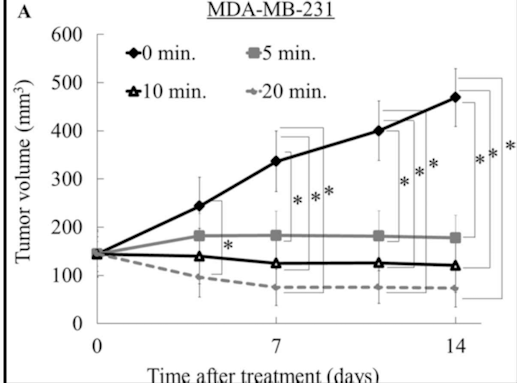

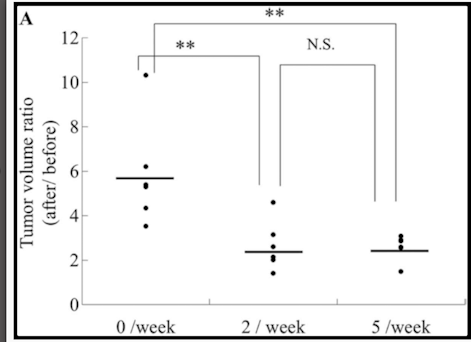
Additionally, using a treatment frequency of twice per week, tumor volumes were smaller with a treatment interval of 3 and 4 days than with a treatment interval of 2 and 5 days.
We also found that transcutaneous CO2 application was ineffective when applied at a distant site relative to the tumor location. Therefore, the CO2 therapy should be applied to the body surface close to the tumor location.
We previously developed an alternative system for CO2 application that can access deep-seated tumors using intra-arterial infusion of saturated CO2 solution (20). These findings suggest that continuous treatment, twice per week with an interval of 3 + 4 days, applied to the local site of the tumor, provides the best antitumor effect for transcutaneous CO2 application.So 20 minutes, enhanced by a co2 capturing gel locally to the tumor site, 2 times per week, every wednesday and sunday (3 & then 4 days), gives max effectiveness
sounds like simple glycerol/glycerin + water could work for the gel,
or sodium alginate
(majority water as long as its thick enough to not run down skin)
https://patents.google.com/patent/JPWO2004002393A1/en?oq=WO2004%2F002393-
A viscous liquid prepared using 2 parts by weight of sodium alginate as a thickener and 98 parts by weight of purified water as water is impregnated into a 4 cm diameter polyester nonwoven fabric, and this is immersed in a 1% calcium chloride aqueous solution to support the nonwoven fabric. A hydrogel film of calcium alginate as a body was prepared, and this was adopted as a carbon dioxide absorption aid 4
-
An appropriate amount of the carbon dioxide absorption assisting material 4 is applied to a 5 mm diameter scratch on the left back of a 37-year-old woman, a left hand is put in the sealed envelope 2, and carbon dioxide is supplied to the sealed envelope 2 by the carbon dioxide supply device 3 to 10 seconds at a rate of 200 milliliters / second, and then 5 minutes at a rate of 20 milliliters / second. When the auxiliary material was washed away, the pain felt before touching the water completely disappeared, and the wound healing promoting effect was confirmed.
-
A 48-year-old man's 5cm square carbon dioxide absorption aid 4 is affixed to the left back of the 48-year-old man, and without putting anything on the right back, each hand is put in the two sealed enclosures 2a and 2b, and each enclosed enclosure Carbon dioxide was first supplied to the material 2 from the carbon dioxide supply device 3 at a rate of 200 milliliters / second for 10 seconds and then at a rate of 20 milliliters / second for 7 minutes.
The man's hands quickly became warm, but the left back felt warmer than the right back.
Gel + ~ 7 Liters of co2 gas sealed in a 20cm long plastic bag was enough for pain reduction and wound healing effect in this woman
I am going through the studies that this Takeshi guy did and there's some interesting ones. Not sure if that one has been shared.
CO2 therapy was just as effective as radiation therapy for this oral squamous cell carcinoma.
But CO2 and radiation combined was a lot more effective. And I suppose CO2 made the radiation a lot safer, as can be seen by the rescued white blood cell count.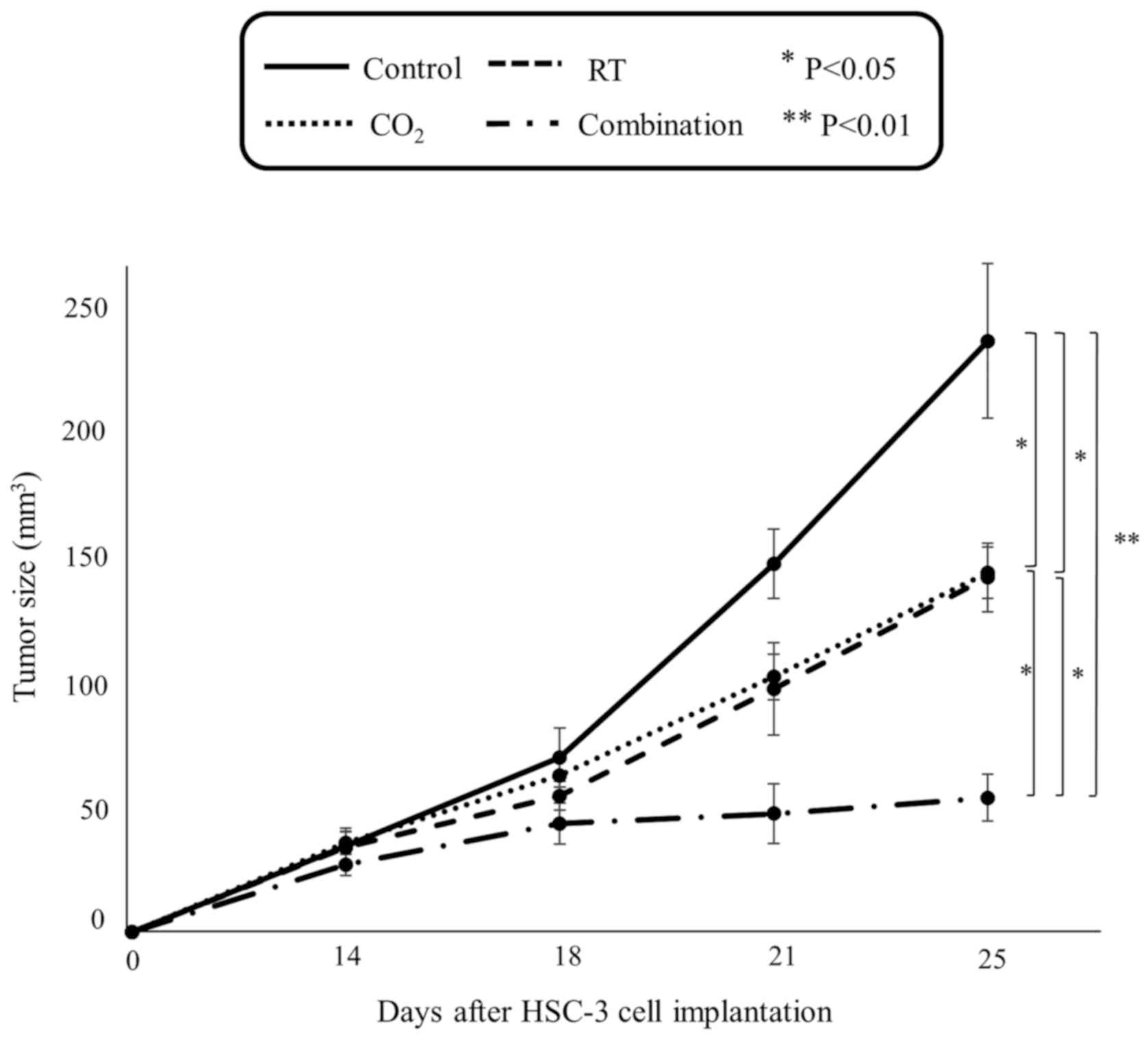
-
@cs3000 Another good one easily accessible,
Simply heating up the body / raising core temp while giving some glucose before stopped breast cancer tumors from growing & even shrank them
https://www.jstage.jst.go.jp/article/thermalmedicine1985/16/4/16_4_229/_pdf/-char/en
Notably, the combined treatment with glucose and WBH suppressed the tumour growth almost completely for 7 days
Cool study, the glucose feeding with the body heating gave an improved effect and even shrank the tumor , (around 40 grams human equivalent glucose)
Just 1 use kept it from growing over a week and shrank it for 5 days, so doing it multiple times a week with a few days between might keep the shrinking effect going continually
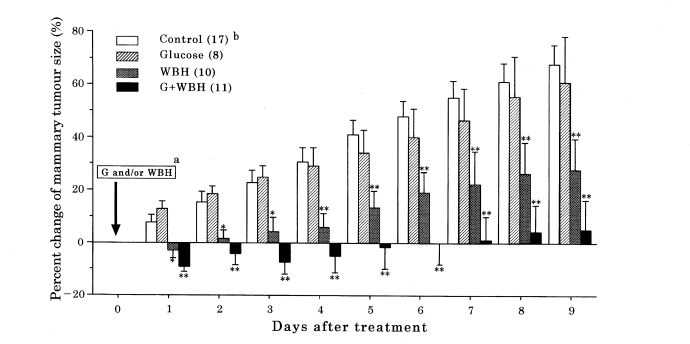
Mammary tumour growth was strongly inhibited in both group WBH and group G+WBH though the degree of the inhibition was much more marked in group G+WBH, in which the growth was inhibited completely until 7 days after WBH compared to 2 days at most in group WBH.
they raised core temp to 39 - 41 degrees over 3 hours, but maintaining 40 degrees+ is where things can get dangerous with cell damage / death. 39 degrees - 39.5 degrees should be manageable and can hit using saunas / portable saunas / baths. (as doing this for hours with metabolism being stimulated i would top up some carb intake every 30 mins)
haidut mentioned in his study about changing cellular pH as a key, authors also mentioned:
This reflects the stimulation of general metabolism and decrease of pH of tumour tissue, which contributes to the tumour growth inhibition
-
the whole "vegetables are le bad" is cringe tbqhwu fam
-
@cs3000 said in 2 studies showing cancer reversal / shrinking:
This reflects the stimulation of general metabolism and decrease of pH of tumour tissue, which contributes to the tumour growth inhibition
https://link.springer.com/chapter/10.1007/978-4-431-67035-3_48
After inducing hyperglycemia by glucose administration, nonheated tumor tissue pH decreased by 0.3 to 0.6, whereas pH of nonheated normal tissue fell by only 0.1 to 0.2, with a slower recovery to the previous level than the tumor tissue. On heating after glucose administration, tumor tissue pH fell from 6.9 to 6.5 immediately after heating with a delay of recovery time after heating. In normal tissue, tissue pH of 7.2 before heating fell to 6.9, rapidly recovering to a level higher than the baseline after the heat treatment. Hyperglycemia caused by glcose administration induced a selective decrease of tumor tissue pH, indicating the possibility of inducing selective heat sensitivity in tumors.
and more on selective action on tumors https://www.jstage.jst.go.jp/article/thermalmedicine1985/17/4/17_4_203/_pdf
Differrent effects on different tumors https://www.researchgate.net/publication/15612753_Apoptosis_in_tumors_and_normal_tissues_induced_by_whole_body_hyperthermia_in_rats
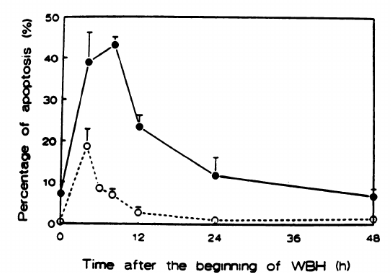
no effect on very aggressive type unless paired with something https://www.tandfonline.com/doi/pdf/10.3109/02656739709023548?needAccess=true&role=button(those are without carbs boosting, so not getting full effect)
22 degrees ambient temp (blue) vs 30 degrees (red) = big difference in tumor growth.
but boosting core temp 1x a week 6 hours to an average of 39 degrees+ didnt have much effect (why a drastically less significant outcome to the other study? it isnt boosted with carbs before but im assuming they ate carbs during those 6 hours. and the other study also showed a decent inhibitory effect without carbs too. is 40 degrees being at the edge of harmful necessary e.g where atp starts to drop in heart ? is 6 hours too long vs 2-3 hours? maybe in the one with more profound effect most of them hit 39.5+ instead of 39? )
Or maybe once a week there wasnt enough to offset the negative effects of the cold temp being 22 degrees instead of preferred thermoneutral 26+ degrees in mice? did the other study use higher housing temp baseline?no, other one used 22-23 ambient temp too
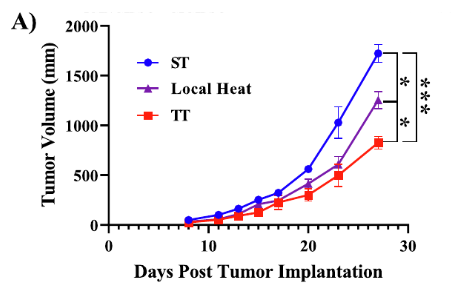
-
insight on what might be good timing for heat therapy
https://pubmed.ncbi.nlm.nih.gov/14023863/ (i've seen in other areas e.g decreasing repetitive behaviours, effects from 1 session can last into 24hrs - 48 hrs later)When you heat cells they gain a temporary heat tolerance when recovering
I guess the main mechanisms with this are 1. heating cancer cells that have poor ability to dissipate heat so more easily damaged + 2. lowering pH to help induce apoptosis (lower pH so capsase can activate properly and self destruct the cell https://www.nature.com/articles/4400779 which happens optimally at 6.4 pH, and in a study i posted it showed glucose + heat took the tumor from 6.9 -> 6.5 and induced a slower rate of pH recovery) probably by increasing co2 with the carbs & stimulating metabolism. so for the first part
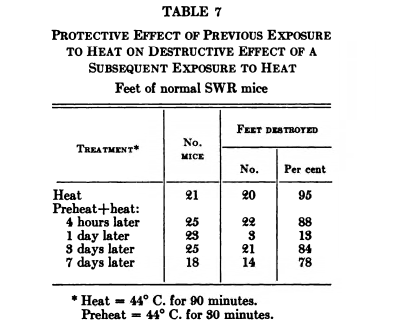
Resistant effect mostly lasts 2-3 days
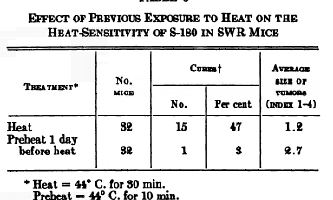
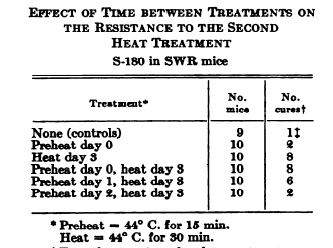
day to day loses its effect
mostly back to normal with 1 day break but not fully,
the heat effect itself is not the only mechanism but going by that,would be 1st day carb+heat session then waiting 2 days after , every 4th day
-
@Mauritio said in Studies showing cancer reversal / shrinking:
@cs3000 said in 2 studies showing cancer reversal / shrinking:
@cs3000 said in 2 studies showing cancer reversal / shrinking:
@Mauritio yep and i imagine daily would be even better, interesting that short duration was effective it does work broadly yeah
here it had less profound effect in a connective tissue cancer but still good
https://www.ncbi.nlm.nih.gov/pmc/articles/PMC3499556/#s2title they did 10 minutes instead of 20 minutes .
I just saw something amazing actually when they tested it on breast cancer in vivo it almost didnt grow at all :Here we go, big one
https://www.spandidos-publications.com/10.3892/or.2017.5591
great studies by these people exploring all the anglesSurprisingly going for more days of co2 weekly didnt give better effect, 2 days is enough,
but going for longer than 10 minutes does give more improvement (20 minutes worked better) in breast & bone cancer, effect peaks around there as 1 hr did not give better effect- Additionally, in a preliminary study, no further decrease in tumor volume was observed with the 1-h treatment compared to the 20-min treatment
- For the CO2 therapy, there was no difference in effectiveness of frequencies of twice and five times per week; in addition, a twice-weekly treatment regimen was sufficient to inhibit in vivo tumor growth, even in MFH/UPS, which is a high-grade sarcoma cell line.
And they found the cancer regressed below baseline with 20 minutes applications, in all of the mice
And they even said two of the breast cancer tumors disappeared @haidut
Bone tumors also got smaller below baseline
.... this is happening fast over a few days / weeks ... amazingit did not work as well on a rarer aggressive sarcoma tumor. but slowed growth with this (which the table doesnt show)
-
in addition, a twice-weekly treatment regimen was sufficient to inhibit in vivo tumor growth, even in MFH/UPS, which is a high-grade sarcoma cell line.
-
In the current study, the most significant antitumor effect was observed in the MDA-MB-231 breast cancer model. At the end of treatment, all treated tumors in the MDA-MB-231 model were smaller than pre-treated tumors, and notably, two of the six tumors in the 20-min group had disappeared



Additionally, using a treatment frequency of twice per week, tumor volumes were smaller with a treatment interval of 3 and 4 days than with a treatment interval of 2 and 5 days.
We also found that transcutaneous CO2 application was ineffective when applied at a distant site relative to the tumor location. Therefore, the CO2 therapy should be applied to the body surface close to the tumor location.
We previously developed an alternative system for CO2 application that can access deep-seated tumors using intra-arterial infusion of saturated CO2 solution (20). These findings suggest that continuous treatment, twice per week with an interval of 3 + 4 days, applied to the local site of the tumor, provides the best antitumor effect for transcutaneous CO2 application.So 20 minutes, enhanced by a co2 capturing gel locally to the tumor site, 2 times per week, every wednesday and sunday (3 & then 4 days), gives max effectiveness
sounds like simple glycerol/glycerin + water could work for the gel,
or sodium alginate
(majority water as long as its thick enough to not run down skin)
https://patents.google.com/patent/JPWO2004002393A1/en?oq=WO2004%2F002393-
A viscous liquid prepared using 2 parts by weight of sodium alginate as a thickener and 98 parts by weight of purified water as water is impregnated into a 4 cm diameter polyester nonwoven fabric, and this is immersed in a 1% calcium chloride aqueous solution to support the nonwoven fabric. A hydrogel film of calcium alginate as a body was prepared, and this was adopted as a carbon dioxide absorption aid 4
-
An appropriate amount of the carbon dioxide absorption assisting material 4 is applied to a 5 mm diameter scratch on the left back of a 37-year-old woman, a left hand is put in the sealed envelope 2, and carbon dioxide is supplied to the sealed envelope 2 by the carbon dioxide supply device 3 to 10 seconds at a rate of 200 milliliters / second, and then 5 minutes at a rate of 20 milliliters / second. When the auxiliary material was washed away, the pain felt before touching the water completely disappeared, and the wound healing promoting effect was confirmed.
-
A 48-year-old man's 5cm square carbon dioxide absorption aid 4 is affixed to the left back of the 48-year-old man, and without putting anything on the right back, each hand is put in the two sealed enclosures 2a and 2b, and each enclosed enclosure Carbon dioxide was first supplied to the material 2 from the carbon dioxide supply device 3 at a rate of 200 milliliters / second for 10 seconds and then at a rate of 20 milliliters / second for 7 minutes.
The man's hands quickly became warm, but the left back felt warmer than the right back.
Gel + ~ 7 Liters of co2 gas sealed in a 20cm long plastic bag was enough for pain reduction and wound healing effect in this woman
I am going through the studies that this Takeshi guy did and there's some interesting ones. Not sure if that one has been shared.
CO2 therapy was just as effective as radiation therapy for this oral squamous cell carcinoma.
But CO2 and radiation combined was a lot more effective. And I suppose CO2 made the radiation a lot safer, as can be seen by the rescued white blood cell count.
Very interesting! RP right again.
So tumor prevention/treatment can be as simple as taking a hot bath and a CO2 bath once or twice a week.
I'm wondering where do heat shock proteins come into play here? They must be raised significantly...
I couldn't find peats newsletter on HSPs but here's the one on body temperature:
https://wiki.chadnet.org/body-temperature-inflammation-and-aging.pdf -
@Mauritio said in Studies showing cancer reversal / shrinking:
I'm wondering where do heat shock proteins come into play here? They must be raised significantly...
I couldn't find peats newsletter on HSPs but here's the one on body temperature:
https://wiki.chadnet.org/body-temperature-inflammation-and-aging.pdfHere is a video that might be of interest.
#51: Heat Shock Proteins | Antibiotic Resistance | DHT Safety | Energy and Aging with Ray Peat, PhDIt has timestamps that do not automatically hotlink on this forum.
00:00 - Start
01:10 - Ray's new newsletter
05:05 - Le Chatelier's principle, Lamarckian fish, Barbara McClintock
09:18 - Gilbert Ling, ATP "the queen of cardinal adsorbents," phase transitions, coacervates, rigor mortis
13:51 - "The role of ATP is not limited to the contraction cycle. It dominates the physical state of muscle even in rest, keeping it soft and pliable... rigor mortis is but a lack of ATP..." Albert Szent-Györgyi
14:43 - Does the activation of the heat shock proteins (HSPs) precede cell division?
16:02 - Niacinamide and solubility, energy loss, DNA repair
19:09 - What about gelatin?
20:85 - Estrogen activates HSPs, redox balance, progesterone inhibits HSPs, water economy
23:15 - Should we activate the HSPs?
25:12 - Will the activation of the HSPs leave a scar?
27:06 - "Energy deprivation stabilizing proteins"
29:37 - Metallic taste in the mouth, lipid peroxidation
30:20 - "Estrogen, hyperventilation, lactate, etc., increase serotonin, and I think it’s serotonin that directly increases PTH, and then PTH increases NO." Ray Peat (2017)
33:30 - The living cell is more susceptible in the fatigued state
38:23 - HSP inhibitors: tetracycline, progesterone, methylene blue, etc.
38:58 - Is PTH a "newer" part of the system?
40:25 - Is RAAS more ancient than the HPA?
40:54 - Ray Peat's newsletter, Progest-E from Kenogen, Ray's history with progesterone
45:24 - Why can progesterone fill-in for the adrenals but pregnenolone cannot?
48:14 - Are pregnenolone and progesterone "true" hormones?
49:25 - If someone has a sensitive stomach -- how can they take progest-E?
50:14 - Ray's thoughts on using DHT and testosterone, gynecomastia, finasteride, governing principles of health
55:40 - Is DHT always "safer" than testosterone? Ray's thoughts on TRT
58:34 - What does Ray think of as a "max dose" of aspirin at one time?
01:00:04 - What happens to the agaratine in mushrooms? Does the mushroom water contain agaratine?
01:01:26 - How to distinguish between a fungal and bacterial infection?
01:07:40 - Does Ray prefer pure olive oil over coconut oil for the carrot salad and mushrooms? 1/2 a teaspoon provides a trace of PUFA
01:08:39 - Are fungal infections rarer than bacterial infections?
01:09:20 - H.pylori infection -- how to treat? Thoughts on dosing antibiotics
01:12:41 - The two-week time frame for antibiotic use scientific?
01:13:45 - Is antibiotic resistance important for the individual?
01:14:28 - Does antibiotic use cause a fungal overgrowth?
01:16:05 - Tetracyclines as antifungals? Inflammation predisposes to infection, feeling "uncomfortable" on minocycline
01:19:16 - Danny's experience on minocycline
01:21:46 - Question: why would a virus want to invade a cell?
01:29:28 - Viruses and weakened organisms
01:30:57 - Do viral pandemics exist?
01:36:02 - “...That is, if one pursues any ‘physical’ illness far enough and deep enough, one will find inevitably intrapsychic, intrapersonal, and social variables that are also involved as determinants.” Maslow (1993)
01:38:08 - What's the factor in the environment that's leading to frailty in young people?
01:40:42 - If a group has a problematic "death culture" holy book -- how can a functioning society be maintained?
01:44:54 - Could a holistic view of science be a foundation for a functional society?
01:45:51 - What is the long-term "artificial" struggle between humans?
01:47:10 - Does authoritarianism have anything to do with nature?
01:49:52 - Did the USA peak in the 1950s? The CIA's profound influence on culture
01:54:10 - Is technology a net-negative for sustaining a free culture?
01:55:25 - What about hierarchy in nature? Is it natural to rule over others?
01:57:52 - If an animal's needs were met, would they not express aggression? "Survival of the fittest," Pyotr Kropotkin
02:01:31 - What would be necessary factors to sustain cooperation among individuals?
02:02:44 - What is the most important news event that Ray is thinking about at the moment?
2:03:28 - The road to serfdom, dollar inflation, stock market manipulation
2:05:51 - Has anything become clearer about what will happen when a large portion of the US becomes jobless?
2:06:32 - Polarization in society (left vs. right, man vs. woman, etc.)
2:09:55 - What was the connection between Karl Marx and the Rothschilds?
2:12:07 - Was the 1917 soviet revolution controlled by Zionists? -
I foud Rays newsletter mentioning HSPs. It's called:
"Cumulative damage,
degeneration, & aging possibilities of reversal"Here's a few relevant quotes:
"...it occurred to me that it
would be good to consider what happens when the body temperature is increased by external heat, beyond the level at which the organism functions optimally. ""Partly, I’m thinking about the damage
that can be done by the increasing popularity of sauna treatments, and various kinds of “hyperthermic therapy for cancer,”"Independently, estrogen and nitric oxide are
known to promote fibrosis and cancer, and now the basic role of HSP in fibrosis (Bonniaud, et al.,2017) and cancer is being recognized, and the drug companies are creating a variety of HSP inhibitors."This quote I included because it's almost poetic and beautiful.
"...time is very relevant to the
organism—its present structure and properties reflect its previous states, and project its future tendencies and possibilities, its trajectory in life."Now this is the most relevant point, which the studies you posted corroborated so beautifully:
"At bedtime, a mild warm bath can compensate for low internal heat production, increasing the metabolic rate and helping to increase glycogen stores and increase progesterone level, making
deep restorative sleep possible. But if the bath is too warm or too prolonged, or if estrogen’s influence is too great, the increased metabolic rate can
Intensify the inefficient metabolism further depleting energy stores, and leading to higher stress hormones. Having extra carbohydrate before and during the warm bath improves its therapeutic function, and decreases the risk of heat shock." -
Very interesting human study on the effect of 60min. exercise (EX) vs. 60min hot bath at 40°C (PH).
Both were comparable in terms of elevating HSP70, but the elevation wasn't drastic and returned to baseline in about 2h.
The pro-inflammatory cytokine IL6 was elevated a lot more from exercise than the hot bath. So overall a hot bath seems to be safer than I thought and safer than exercise.
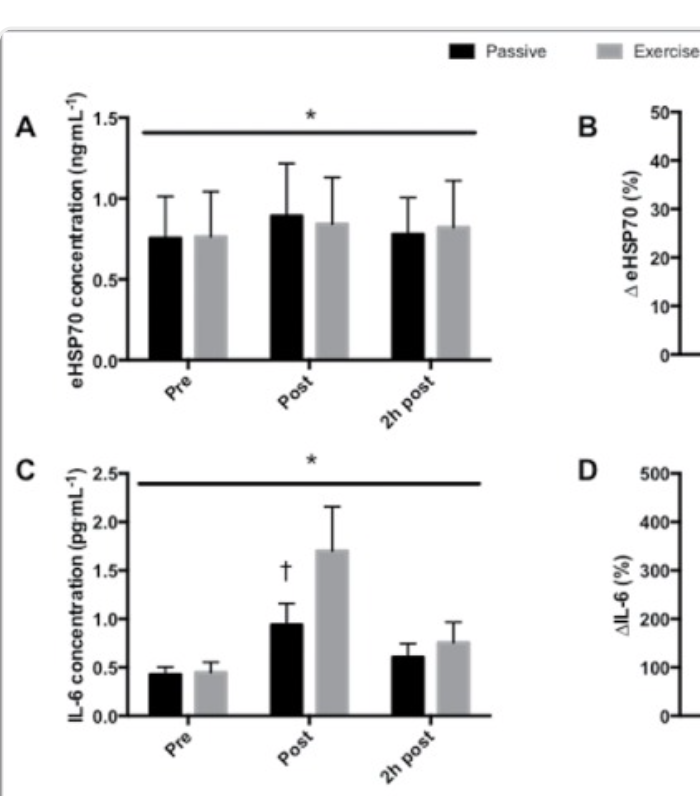
Interestingly just sitting in a hot bath for an hour increased their resting energy expenditure by 79%! That's what they found.
What makes the bath so good for tumors is the increase in temperature.
Both methods were comparable at raising core temperature.
But the bath was a lot better at increasing skin and muscle temperature compared to exericse!
https://pmc.ncbi.nlm.nih.gov/articles/PMC5605168/
@cs3000 @DavidPS -
 C cs3000 referenced this topic on
C cs3000 referenced this topic on
-
replied with more discussion on HSP at https://bioenergetic.forum/post/32387
-
B-lapachone and breast cancer reversal when Nqo1 is expressed, (used 2 lines that dont have nqo1 then made them express nqo1, like a lot of cancers do maybe most)
Breakthrough dose was 70mg/kg every other day for just 5 uses (65mg/kg slowed a lot but didnt reverse interestingly). In one of the types (B) the cancer basically didnt even grow at all.
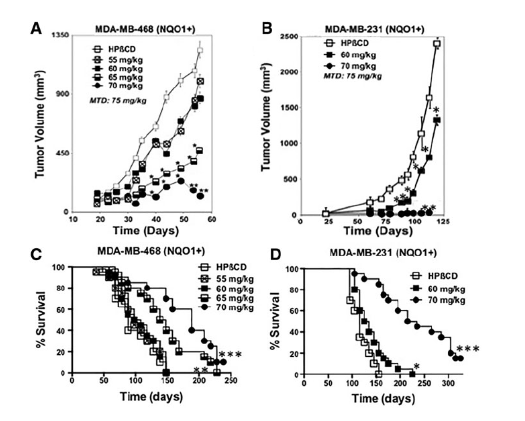
(would more treatments work for smaller doses?)
~(the effect relies on cells having NQO1 activity,
Cancer cells expressing >100 U of NQO1 enzyme activity are killed, while normal tissues that lack, or express low levels of, NQO1 are spared,
because high NQO1 metabolises the quionine into an unstable compound that causes a big surge in superoxide which generates h2o2 overload and kills the cell, shown at 4uM.
but the effect is somewhat selective on cancer cells vs healthy human cells which have less NQo1, at least up to 10 uM it doesnt kill at least some healthy cells measured. but does drastically inhibit proliferation of healthy cells >1uM.)in human breast cancer tissue microarrays,*60% (12/20) of breast cancer tissue samples showed strong NQO1 expression, while low to no significant expression wasnoted in adjacent normal breast tissue
NQO1 is a flavoprotein that is over-expressed approximately 5- to 200-fold compared with normal adjacent tissue in various solid tumors, including cancers of the pancreas, lung, prostate, and breast
~~But these are high and possibly toxic doses,
generally only 1mg/kg - 2.5mg/kg (~5mg-10mg human) are used for effects, maybe best at lower doses but regularly, combined with different things,~~considering the level of toxicity for NQO1 expressing tumors i'd wanna be extra sure there arent healthy tissues somewhere that express elevated amounts close to what cancers do , if using these high doses if theyre even reasonable to get ahold of, some healthy tissues express it to some extent eyes lungs etc https://doi.org/10.1016/S0891-5849(00)00310-5
~~here mice ate 70mg/kg in diet though and it showed beneficial effect on multiple measures in aging , and increased lifespan +17% in stress https://pmc.ncbi.nlm.nih.gov/articles/PMC3469505/#s3 but they didnt look at all tissues to see if theres damage,
I guess in food its less bioavailable mixing with other things so effectively a much lower dose (?)But here 80mg/kg orally just once showed signs of liver & kidney toxicity https://www.scielo.br/j/jbpml/a/6RX9dwWpVrnCVVFxp5gFjfr/?lang=en
The measured oral bioavailability of β-lapachone was 15.5%.
~~here 50mg/kg, injected i.p, but spaced out 1 day apart, for 10 treatments https://www.pnas.org/doi/10.1073/pnas.96.23.13369#sec-2 significantly lowered ovarian cancer and judging visually and by bodyweight didnt notice significant toxicity during this timeframe
**here ** 50mg/kg twice a day injected I.P increased mortality and was highly toxic https://www.tandfonline.com/doi/pdf/10.4161/cbt.4.1.1382 ,
Unlike the just 5 rounds dosing 1x every other day in the 1st studyβ-lapachone given for a dose of 50 mg/kg I.P. twice a day for two weeks was extremely toxic with nearly one-half of animals dying during the treatment.
{this might have been due to what they combined it with but maybe not}
Clearly complexation of β-lapachone with HPβ-CD increases the
bioavailability, efficacy, and toxicity of this active antipancreatic
cancer agent. Future studies to improve solubility with decreased
toxicity are warranted.and here 10mg/kg daily but injected into the blood for 1 - 2 weeks showed higher death rates https://www.scielo.br/j/bjmbr/a/pf9P7yD9qDP79yV5bDvPjqb/?lang=en
So the first study showed a survival increase doing just 5 treatments with a day apart. I guess you avoid lethal toxicity this way but idk how certain tissues would be affected , theres a tradeoff with that
I would only be happy using low dose for more treatments over time, if that had efficacy will see if i find anything
,
Lower dose 12.5mg or 25mg/kg subcutaneous daily https://www.nature.com/articles/s41598-017-02937-0#Sec2
slowed well but did not shrink alone
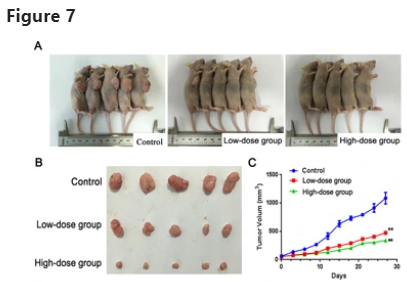
Lower doses orally, maybe ~5mg-10mg daily if not ~30mg human equiv, have a preventative effect on generating cancer. has a sedative effect https://www.sciencedirect.com/science/article/abs/pii/S0014299924001997
-
Human trial with methylglyoxal {aka pyruvaldehyde} (william Koch compound)
https://web.archive.org/web/20161017113947/http://www.cancer-therapy.org/CT/v4/B/HTML/17. Talukdar et al, 205-222.htmlLong term in a variety of cancers, ~80% of the people had remission or stability @dapose
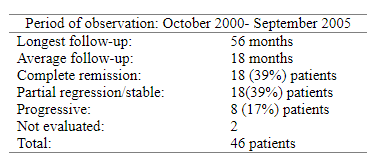
Its found in mankuna honey but the amounts they used here were high at ~500mg x4 a day (in water, just a little 60ml so dont tip pH too high?, with food) + vit c and some b vits, and over a long timeframe. seeing if i can find how long the effect should take. methylglyoxal levels go up with high blood glucose & finding glyoxalase 1 inhibitors to use should increase the effect for a lower dose needed https://www.cancertreatmentsresearch.com/methilglyoxal/ (nice writeup) looking up toxicity, apparently taking creatine can protect healthy cells so this has a selective effect
No significant toxicity (but can take creatine and vit C to enhance effect and protect healthy cells just in case there's toxicity on the heart without)
https://doi.org/10.1016/j.taap.2005.07.003Acute toxicity study was done with two species of animals, mouse and rat. The maximum dose of methylglyoxal for each mouse was for oral 2 g, for subcutaneous 1 g and for intravenous 0.3 g
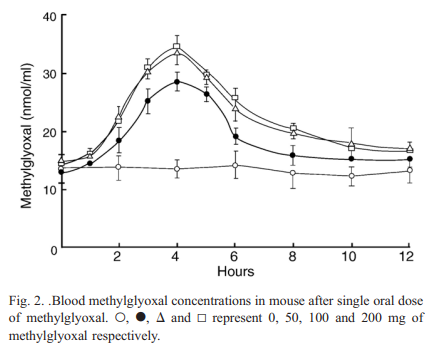
All the animals except those used for biochemical studies (see below) were observed up to 90 days after completion of the treatment and were found to remain healthy. No toxic effect on physical condition and behavioral pattern such as hair texture, food intake etc. and death were observed. However, the subcutaneous injections appeared to be painful for both treated and control groups. {diluted in saline too} The pain appeared to persist for several minutes after injection.
In the animals, which received intravenous injections, swelling appeared in the tail and adjoining regions from 3rd week of the treatment. The swelling remained up to about 10 days from end of the treatment.
Treatment of methylglyoxal had no toxic effect on the
functions of liver, kidney and heart and hemopoietic organs
of the rats- As mentioned before, methylglyoxal had been found to possess strong antitumor activity. Szent-Gyorgyi and his associates and Apple and Greenberg long ago showed remarkable antiproliferative and curative effects of methylglyoxal towards cancer-bearing animals (Szent-Gyorgyi et al., 1967; Egyud and Szent-Gyorgyi, 1968; Apple and Greenberg, 1967).
- In in vivo and in vitro studies with animals and in vitro studies with a wide variety of human post-operative malignant tissue samples, we had observed that methylglyoxal acted specifically against malignant cells and ascorbic acid significantly augmented this anticancer effect of methylglyoxal (Ray et al., 1991, 1997a, 1997b; Biswas et al., 1997). Moreover, we had observed that creatine present in cardiac cells completely protected the animal from any possible deleterious effect of methylglyoxal treatment on cardiac mitochondria (Sinha Roy et al., 2003).
- So, we tested whether these compounds had any curative effect on mice inoculated with EAC cells. The results are presented in Table 7. It appears that at a particular dose the antiproliferative effect of methylglyoxal is augmented in presence of ascorbic acid and further improved when the mice were treated with methylglyoxal in combination with ascorbic acid and creatine. Nearly 80% of the animals treated with this combination were completely cured.
In mice 30mg/kg methylglyoxal slowed tumor development but 30mg/kg + 50mg/kg vit C + 150mg/kg creatine = 0 tumor development,
and regression into tumor free by day 10 but this was in tumors that just started growing
so gram amounts might not be needed if combined with creatine and vit C, was injected i.p so without food if thats tolerable, bumping up because of i.p ~300mg daily might be effective over time combined with 250mg vit C and 1gram creatine, split into 2 doses 6 days a week, maybe adding a couple more grams creatine would work better too
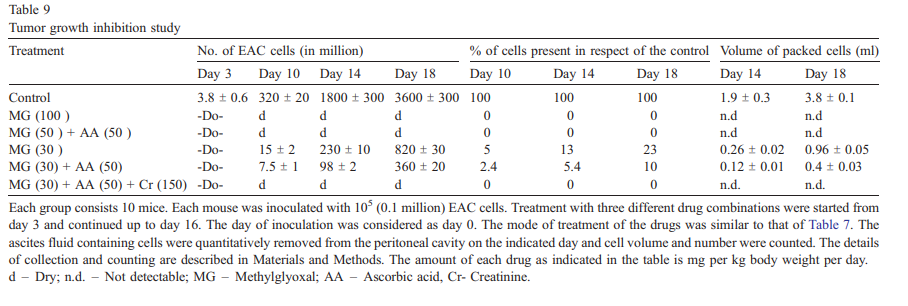
Creatine supplementation with methylglyoxal: a potent therapy for cancer in experimental models. Amino Acids, 48(8), 2003–2013. doi:10.1007/s00726-016-2224-1
20mg/kg but i.v + vit c + creatine (started on day 7,)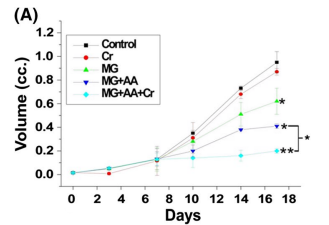
-
Very interesting . I guess the mechanism would be its oxidizing effects?
Ray talked about it a few times in his newsletter and it didn't sound positive.
Also methylglyoxal is a naturally occuring of glycolysis (not oxidative phosphorylation) so it should be higher in unhealthy people . Plus it can be converted into lactate, which is the body's way of detoxing it.When you read studies on it, it doesn't sound encouraging, it's seen as cause of diabetes and other illnesses.
Shouldn't it be very good for diabetes if it's so pro-metabolic ? Maybe it rises as a defense mechanism ."...MGO is linked to the development of diabetes, vascular complications of diabetes, and other age-related diseases."
https://pubmed.ncbi.nlm.nih.gov/31539311/Methylglyoxal is a major cell-permeant precursor of advanced glycation end-products (AGEs), which are associated with several pathologies including diabetes, aging and neurodegenerative diseases.
https://pubmed.ncbi.nlm.nih.gov/25709564Then there's this quote by Peat.
https://raypeatexplained.com/ray-peat-on-oxidation/#152124319605143112494046561751189594877And this study showing dietary intake being associated with less low grade Inflammation.
https://pubmed.ncbi.nlm.nih.gov/36055771/ -
@Mauritio its an aldehyde so doesnt sound like a healthy compound / pro metabolic outside of specific use nah (probably best not to take generally outside of cancer) so its one of those things that has an outweighing effect on cancer cells, the anti-cancer dose didnt show toxicity though so i guess healthy cells can deal with that amount well enough but probably some extra burden
apparently low amounts can stimulate cancer growth but higher amounts triggers the apoptosis process (thats normally lacking because of damage making it inefficient, and pH change, needs to be more acidic inside the tissue for apoptosis to happen optimally, cancers are acidic nearby but higher end pH inside - maybe methylglyoxal accumulation makes the tumor more acidic?)
Also it has two carbonyl groups , koch and reinstorff back in the day thought these can be used to take out things with strong bonds that are sticking around blocking mitochondria respiration and enable healthy processes again. maybe @dapose has more to to say on that
Following Glo1 inhibition, cancer cells switch from glycolysis to tricarboxylic acid (TCA) cycle to avoid apoptosis induced by MGO accumulation.
for some reason cancer cells are more sensitive to MGO overload than normal ones even though they have higher glutathione (which sounds to me like the effect is less about damage and more about re-enabling apoptosis unless for some reason they accumulate extreme amounts) https://www.science.org/doi/10.1126/science.160.3832.1140.a
-
@cs3000 ok thanks.
-
I feel like oleocanthal and oleurupin deserve more attention.
Check this out. 97% reduction in cancer growth in-vivo!
Mostly by inhibiting estrogen.
But it's also been shown to be effective in other cancers.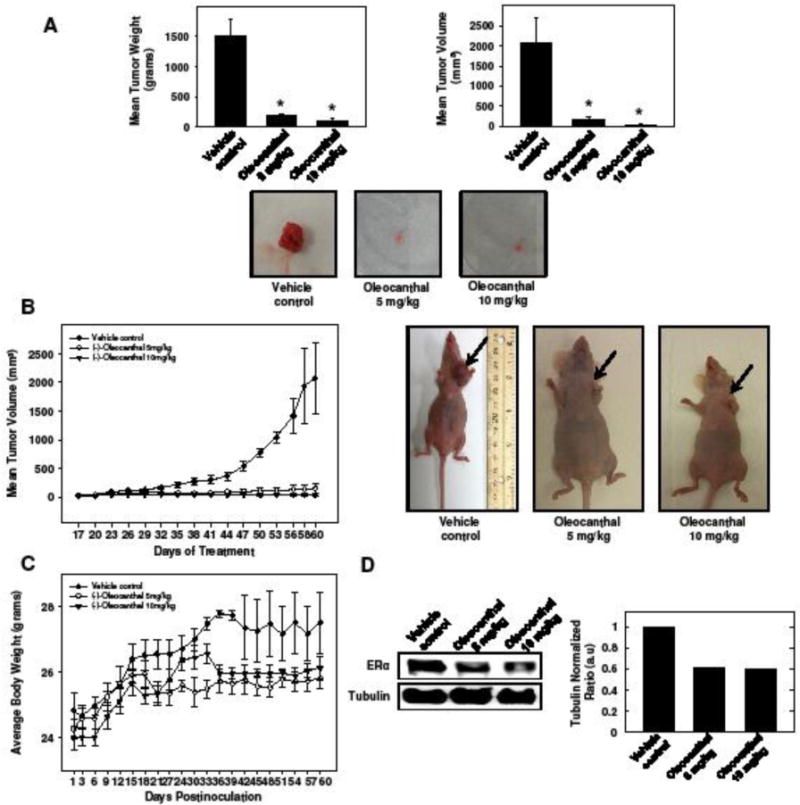
"Treatment with 5 mg/kg or 10 mg/kg (−)-oleocanthal resulted in 97% inhibition of tumor growth in orthotopic athymic mice bearing BT-474 tumor xenografts compared to vehicle-treated animals. (−)-Oleocanthal treatment reduced total levels of estrogen receptors in BT-474 cells both in vitro and in vivo. "
"Anticancer activity of (−)-oleocanthal has been demonstrated in different tumor types including breast carcinoma, prostate carcinoma, hepatocellular carcinoma, colon cancer, melanoma, and multiple myeloma (Akl et al., 2014; Elnagar et al., 2011; Fini et al., 2008; Fogli et al., 2016; Pei et al., 2016; Scotece et al., 2013)"
-
farcarinol (from carrots and related plants like ginseng) and related compounds for colon cancer
also knows as panaxynol or carotatoxin
interestingly-- the nrf2 stimulating activity is apparently higher in relevant dietary doses from carrots than it is from cruciferous vegetable. another contradiction in the peater world
-